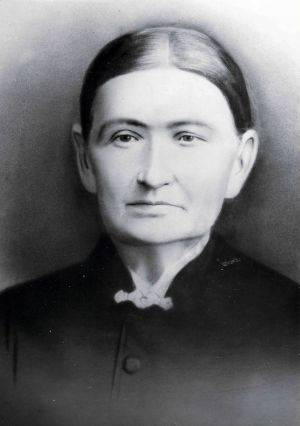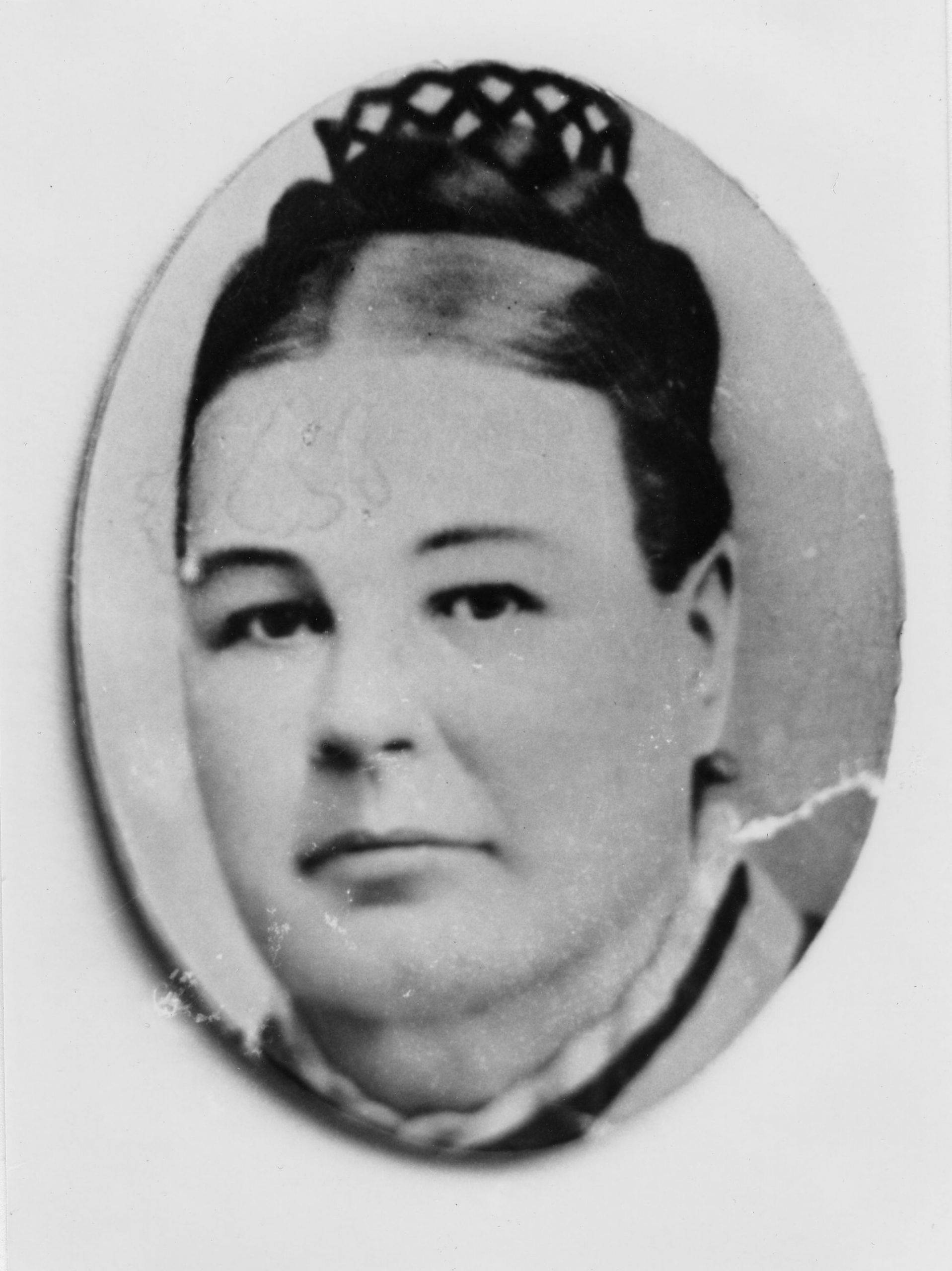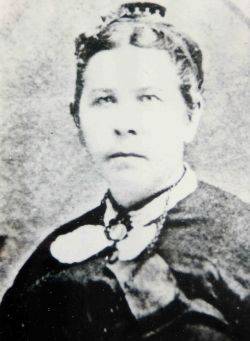“About the year 1800, in the little town of Lee, Berkshire County, Massachusetts, near the border of New York, lived the family of Elisha and Sally Hulett Whiting. Elisha Whiting’s father was a sea captain and lived in Connecticut. He died when Elisha was very young. His mother, not knowing what else to do, bound him to an old Quaker, who was very cruel to him, and after a few years, he ran away to Massachusetts and worked on a farm with a wheelwright. Here he was married to Sally Hulett. They were highly respected, honest, generous and firm in their convictions.
Elisha Whiting followed the trade of wagon and chair maker and did his work well. His wife was very gifted in making prose and poetry, a characteristic that has been bequeathed to many of the Whiting descendants. To Elisha and Sally Whiting, twelve children were born, eight sons and four daughters as follows: (1) Charles, (2) William, (3) Edwin, (4) Charles, (5) Katherine Louisa, (6) Harriet, (7) Sally Emeline, (8) Chauncey, (9) Almond, (10) Jane, (11) Sylvester, and (12) Lewis.
Edwin Whiting was born September 9, 1809, the third child of this family.
When he was six years old, his parents moved to Nelson, Portage County, Ohio. At that time, it was the western frontier of the U.S.A. but probably the very his father wished to be to get a suitable timber for his trade, for the support of his large family.
Edwin Whiting’s chance for education was very limited, but they were all taught the “3 R’s”,Readin’, Ritin’, and Rithmetic, and he wrote an legible hand, an extraordinary feat for his time. At an early age, he wrote credible verse. His early life in the forest, no doubt, accounts for his love of the out-of-doors, the beauties of nature, the trees, the flowers, the mountains and the desire to hunt. One Sunday morning, when but a small boy, he decided to go hunting. He knew this was contrary to his parent’s teachings, so he tried to draw his gun through the cracks between the logs of his bedroom and go unmolested. His gun caught and was discharged, inflicting a serious wound in his left arm. This, he said, was a lesson to observe the Sabbath Day and to obey his parents.
He learned the chair making trade from his father and his workmanship was considered very good. In 1833, when Edwin was twenty-four years old, he married Elizabeth Partridge Tillotson, an Ohio girl of French descent. She was a highly educated school teacher, quite an accomplishment for those days.
In 1837, the Gospel was brought to the Whiting family. Edwin and his wife, his father and mother and some of his brothers and sisters joined the Church of Jesus Christ of Latter•day Saints. They were baptized by Thomas Marsh in 1838. Here, as in the time of Christ and His Apostles, the humble, hard-working class of people were the ones to listen and accept the Gospel of truth. They were among the early members of our church and soon joined the saints in Kirtland, Ohio.
It was here that their trials, hardships and persecutions began and it took true manhood, womanhood and faith in God to endure. They were forced to leave their new comfortable home, complete with furniture, orchards and land in Kirtland, Ohio and took only their clothing and a few valued relics and went to Far West, Missouri. By this time, Edwin and Elizabeth had four children: William, Helen Amelia, Sarah Elizabeth and Emily Jane. They were only in Far West a short time and had just built a new home, when the mob, several thousand strong, ordered them out. Every house in the village was burned except father Elisha Whiting’s, which was spared because he was so sick then could not move him. We remember of hearing aunt Elizabeth tell how she sat on the pile of bedding far into the night with little daughter Jane in her arms. Little Jane died soon after from exposure and lack of proper food. Sarah clapped her hands at the big bonfire the mob had made with their fences and the select wood from her father’s chair shop. They were compelled to flee again so they joined the saints at Lima in father Morley’s branch, where Edwin Whiting acted as counselor to brother Morley.
For Several years, the saints were happily building up the city of Nauvoo, and their temple. Here they worshiped God without so much persecution as they had experienced at Lima. Edwin was appointed Colonel in the Nauvoo Legion and was an active worker at all times for the up-building of His Church. Through the advice of those in authority, and for a righteous purpose, he entered the law of plural marriage. On January 3rd 1845, he married Almira Meacham. The following year, January 27, 1846, they were sealed in the Nauvoo Temple, and also to Mary Elizabeth Cox, his third wife.
That same year, he was called on a mission to Pennsylvania and was there at the time of the martyrdom of the Prophet Joseph and Hyrum Smith. He soon returned home and took up arms with his brethren to protect his property and the lives of his family.
During the battle of the Crooked River, his brother Charles was killed. Still a greater test awaited him, his brothers, Almond, Sylvester, Chauncey and Lewis and his sister, Louisa did not feel that Brigham Young should be the leader of the Church so they followed Alpheus Cutler and called themselves “Cutlerites” and moved up into Clitherall, Minnesota. To this day they hold tenaciously to the teachings of the Prophet Joseph Smith. They still correspond with the children of Edwin Whiting, and have given us, for temple work, an extensive genealogy of the Whiting family.
Edwin Whiting, his families, his father and mother stayed with the saints, who were compelled to move west as far as Mt. Pisgah, (now known as Talmadge) Iowa. There they stayed to prepare for the journey across the plains. The dreaded disease, cholera, took the father and mother of Edwin, his little brother and little daughter, Emily Jane. Their names are on the monument lately erected at that place in memory of those who died there. So many of his family were sick at one time, that there was no one well enough to get the sick ones a drink, but even in those trying times, they still had faith and rejoiced in the Gospel, for the Lord was with them.
Emeline, a sister of Edwin, married Fredrick Walter Cox and the two families were as one big family for years. They established a chair factory and hauled the chairs to Quincy, Illinois where they were sold. From this and their crops, they prepared to come west. Aunt Mary taught school two terms and helped the family some. While at Mt.Pisgah, three children were born. Albert Milton was born to Mary. Oscar Newell was born to Elizabeth, and Catherine Emeline was born to Almira.
In April, 1849, Edwin and Emeline, the only children of Elisha and Sally Whiting who stayed true to the Church, started westward in brother Morley’s company.
Volumes have been written of the westward journey of the saints, and as Congressman Leatherstood has said, “It is the greatest emigration trail that was ever blazed, and our pioneers will, some day stand out in history as the greatest pioneers of the world.” They fought Indians, had their cattle stampeded, suffered for lack of proper food, and even though tired from that long and tedious trek, still they went on. After reaching the Black Hills, a heavy snowstorm came and for three days they were shut in. Many of their cattle died and perhaps they would have died had not the teams and provisions sent by President Brigham Young come to their aid.
On October 28, 1849, they reached Salt Lake City, which looked like a haven of rest to that travel•worn company. Aunt Mary said, “I have never beheld a sight so good and so beautiful as Salt Lake City. We were so thankful our journey was at an end.” But their rest was of short duration, for in a few days Edwin Whiting, the Morley’s and the Cox’s were called to settle the San Pitch River, now known as Manti. Again they journeyed on. It took three weeks to go from Salt Lake City, because they had to build their own roads. Provo was then a village of about six homes.
As they passed Hobble Creek, afterwards known as Springville, Edwin Whiting remarked, “This is a fertile spot. I would like to stop here.” They arrived in Sanpete county on December 1, 1849, with almost nothing to eat, no food for their cattle, no shelter to keep them warm, and cold weather upon them. They made “dugouts” on the south side of the hill where the Manti Temple now stands. It was a severe winter, with snow so deep the cattle could scarcely get grass and most of them died. Food had to be divided with the Indians to keep peace. President Young had promised them provisions and help, but none came, so Edwin and Orville Cox put on snow shoes and with a little parched corn in their pockets for food, placed their bedding on a sleigh and started toward Salt Lake City for help. When they reached Nephi Canyon, they met their help, brother Dace Henry, his wife, her brother, Mr. Doge and an Indian, snow bound. Their cattle had died and their wagons were all but covered with snow. The young wife was very sick, so Edwin gave them the sleigh to pull her to Manti. They put their quilts on their backs and walked on to Salt Lake City and reported conditions to President Young. Aid was immediately sent, but some of that company went back to Salt Lake City.
Edwin’s family now numbered fourteen. They lived in a large room in the wall of the hill with their chair factory in one end. The men and boys hauled wood from the hills on the hand sleighs.
The following spring (1850), there were three girls born. Harriet Lucinda was born to Mary Elizabeth in April, Louisa Melitia was born to Elizabeth in May, and Cornelia Dolly was born to Almira in June.
For several seasons, very little was raised. It became necessary to build a fort to protect themselves from the Indians, for they felt that the white man had stolen their land. The gates of the fort were locked while the men went to the fields with their guns. From this developed the Walker War. Edwin was appointed Captain of the Militia. Twice the Indians drove his cattle off and stole whatever they could.
Edwin often told us of one big old ox that he owned. The ox would rebel whenever an Indian tried to drive him. He would turn on his captors and break their defense and come home. He hated Indians and would always lower his head and challenge them if they came near. Edwin tried planting fruit trees, shrubs and flowers, but they could not survive the very cold winters. Their crops were poor, but they managed to exist and were a happy family in spite of their hardships.
In 1854, he was called to Ohio on a mission and was gone for two years. While he was away, the grasshoppers came and took everything they raised. They faced starvation, but miraculously, where the crops had been, a patch of pigweeds grew and they lived on them until the corn ripened in Utah County. A strange thing it was, for the Indians said those pigweeds had never grown there before, nor have they grown since. Walter Cox divided with his brother’s (brother•in•law) family while Edwin was away.
Edwin, upon his return, brought many kinds of fruit trees, (some from his father’s farm that he helped to plant when a boy) shrubs and flowers, and again tried to grow them, but the climate was too cold.
On the 8th of October, 1856, Edwin married Hannah Haines Brown. Abby Ann Whiting was born to this couple at Manti in 1858 and Lorenzo Snow Whiting was born at Manti in 1860.
On the 14th day of April, 1857, he married Mary Ann Washburn. Two children were born to the family while they resided at Manti. Daniel Abram was born in May, 1858 and Monroe Finch Whiting was born in November, 1862.
While he lived at Manti, Edwin was among the foremost men in religious and civic affairs of the community. He was councilor to the Stake President. He was mayor of the city from 1857 to 1861. He was a member of the legislature for two terms, and as stated before, he was Captain of the Militia in the Walker War.
After finding the climate of Manti unfavorable for raising fruit, his special work, he was advised by President Young to try out his nursery at Springville. He moved to Springville in 1861 and was able to plant and grow all kinds and varieties of fruit trees, vegetables and flowers. People used to come from neighboring communities to see his flowers.
He built a home on the lot where the Springville Second Ward Church now stands. That old two story adobe home will stand in the memory of the members of the Whiting Family as a place of many happy evenings and of fun and amusement. Aunt Mary also taught school there.
He transplanted, in different towns, many evergreens from the mountains. Those around the old Court House in Provo, those at the Springville City park, and one large evergreen that stands southwest of the Manti Temple which can be seen for miles around. He once said “I brought that in my dinner bucket and I think it was the first evergreen transplanted in Utah.”
His life was typical of this great tree. A poem written by Emmay Whiting, wife of Daniel Whiting, describes his life and this tree as being similar. Edwin had one of the largest families in Utah. Many of those stand at the head of Stake and Ward organizations in our Church. Among his descendants, we found seven bishops.
In his later life, he did temple work for his dead relatives in the Salt Lake Temple, St. George Temple, and in the Logan Temple.
He lived the principles of his religion. He was honest, charitable, and never accumulated great riches. He was thrifty and loved his wives and children and gave them the comforts of life.
He died at Mapleton, Utah on the 9th of December, 1890 at the age of eighty-one years. He was firm in his belief and testimony of the truthfulness of the Gospel.
His descendants are numerous and are found in Idaho, Arizona, Mexico, California, New York, and in Utah. [1919]
Compiled by Jennie Bird Hill, granddaughter of Abby Ann Whiting, daughter of Edwin and Hannah Whiting 1919
Source: Marie J. Whiting Collection









